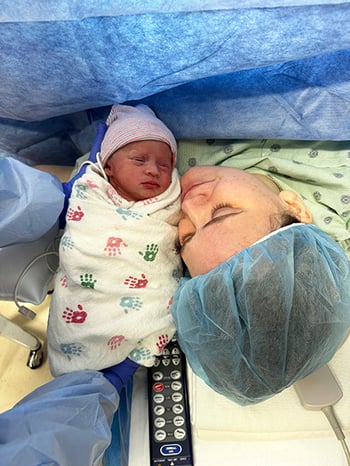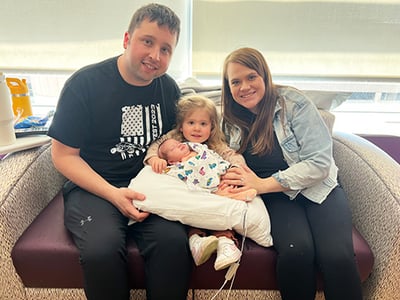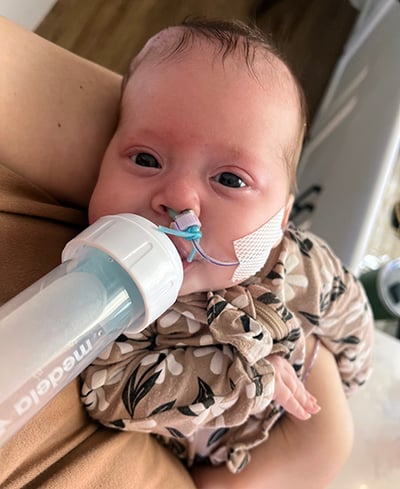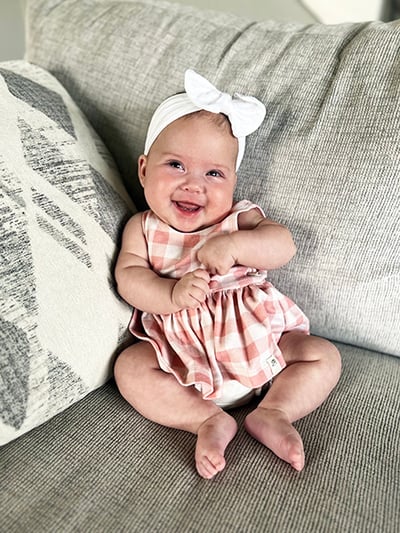
Home sweet home: How a unique Children’s Wisconsin program is getting babies home faster than ever
On April 19, 2024, Collins Mae DeValk was ready to go home.
Collins has been in the Children’s Wisconsin Neonatal Intensive Care Unit (NICU) since she was born, more than seven weeks early, on March 8. It had been a long hospital stay and Alyssa and her husband, Jordan, were excited and eager to get home. But there were some nerves and anxiety mixed in, too. In the hospital, Collins had 24-hour care and a team of medical experts at the ready if anything were to go wrong. At home, they wouldn’t have any of that. Or so Alyssa thought.
Eating may seem like a simple and intuitive skill that comes naturally to babies. But it’s often not, especially in babies born prematurely. Collins actually took a bottle only a few hours after she was born, but quickly regressed.
 “When she took a bottle, we were like, ‘Oh my gosh, this is phenomenal,’ because she's 33 weeks and shouldn’t really be doing this,” Alyssa said. “But then I think her little body remembered she was 33 weeks old and she was like, ‘You know, eating is really hard.’”
“When she took a bottle, we were like, ‘Oh my gosh, this is phenomenal,’ because she's 33 weeks and shouldn’t really be doing this,” Alyssa said. “But then I think her little body remembered she was 33 weeks old and she was like, ‘You know, eating is really hard.’”
So when it’s time for an infant like Collins to be discharged from the hospital, but they’re not yet able to eat enough by mouth, there are generally two options.
One is they can be sent home with a gastrostomy tube (G-tube), which is a tube that delivers nutrition directly to the stomach through a tube in the belly. A G-tube requires surgery to be placed and removed, and tends to be more of a long-term, or even permanent, option.
The other possibility is a nasogastric tube (NG-tube), which is a thin tube that is inserted through the nose and down the throat into the stomach. That’s what Collins had placed while at Children’s Wisconsin to help her gain weight. While generally a more temporary solution, most pediatric institutions across the country prefer not to send infants home with an NG-tube.
“NG-tubes can often accidentally get dislodged. There are risks of aspiration, not getting enough nutrition, if the tube does come out. And an NG-tube has to be replaced every four weeks, so there are a lot of follow-up appointments,” said Julie Lavoie, PhD, AC-PNP, program director of the Eating Disorders and Enteral Feeding Program at Children’s Wisconsin. “So, for a lot of reasons, they just haven’t been popular as nutrition support at home.”
What that means for many patients with NG-tubes is they have to remain in the hospital for additional weeks or months. And if Collins had been born just a few years earlier, that likely would have been her course of treatment as well.
But thanks to Dr. Lavoie and the Enteral Feeding Program, Collins had another option.
A novel idea
 In 2019, Dr. Lavoie was finalizing her PhD dissertation at Marquette University. She was highlighting the use of a device called a nasal bridle, which is essentially a thin rubber tube and plastic clip that secures an NG-tube in place. While often used for adult ICU patients, Dr. Lavoie was showing that it was an effective option for pediatric patients as well.
In 2019, Dr. Lavoie was finalizing her PhD dissertation at Marquette University. She was highlighting the use of a device called a nasal bridle, which is essentially a thin rubber tube and plastic clip that secures an NG-tube in place. While often used for adult ICU patients, Dr. Lavoie was showing that it was an effective option for pediatric patients as well.
“Most pediatric hospitals aren’t familiar with how to place a nasal bridle. They think it’s rather barbaric,” said Dr. Lavoie. “But the procedure is actually simple and painless. The bridle is placed in the nose using magnets, with no sedation and no incisions. We’ve proven it’s effective and now it’s a relatively standard practice for us.”
That was the birth of the Children’s Wisconsin Enteral Feeding Program, the first pediatric bridal program in the country.
“The last couple weeks in the NICU, Collins was just working on feeding,” said Alyssa. “So we were eager to get her home. And with this program, she could.”
The seed of this idea was planted earlier in Dr. Lavoie’s career, working in the Children’s Wisconsin Cardiac Intensive Care Unit preparing feeding plans for babies.
“I started as a dietitian and so my true love is nutrition, and the growth and well-being of children,” said Dr. Lavoie. “Nutrition is often what gets these kids home. If they can eat, grow and thrive, they can go home. But many could not and I saw how these families were really struggling. I knew that we not only could, but we should be doing better by these patients.”
And that they certainly have. On average, the Enteral Feeding Program has been able to decrease the length of stay in the NICU by 14 days. Every year, the Enteral Feeding Program sends about 180 kids home with an NG-tube and bridle.
“That's a lot of days. That's a lot of money. That's a big deal,” said Dr. Lavoie. “We know babies do better at home and the bridle program opened the door to that.”
Staying connected
 Even with all their successes and the thousands of families they helped, Dr. Lavoie and her team weren’t satisfied. In December 2023, they collaborated with the Children’s Wisconsin Digital Health and Experience Team and introduced an additional feature — remote patient monitoring (RPM).
Even with all their successes and the thousands of families they helped, Dr. Lavoie and her team weren’t satisfied. In December 2023, they collaborated with the Children’s Wisconsin Digital Health and Experience Team and introduced an additional feature — remote patient monitoring (RPM).
Previously, a baby would go home with a bridled NG-tube and the care team would only hear from them at their follow-up appointment — or if something went wrong. But with RPM, families are able to stay in constant contact with their care team from home.
“The remote monitoring is a way to create a tethered cord between families and the medical team,” said Dr. Lavoie. “Being able to open up Epic, look at the digital health platform and see what that baby's doing every single day, that has made providers feel a lot safer about sending a baby home.”
Prior to discharge, Dr. Lavoie and her team connects with an interested family, sets up the Locus app on their phone and gives them a Bluetooth scale. With that, they’re able to track their baby’s daily weight, food intake, and how much was given by mouth or through the tube — right from their phone. All that data is uploaded directly to their electronic health record in Epic, which is reviewed daily by the enteral feeding team.
“Families can call us directly with any feeding issues,” said Dr. Lavoie. “Every week, I or one of the other nurse practitioners will call the family just to check in and see how they're doing.”
“It was really easy to use,” said Alyssa. “They were excited about the program, and so were we.”
Even more amazing, if specific marks aren’t being met, the enteral feeding team will receive text alerts on their phone in real time.
“One day, we got a big red alert on the app saying your baby lost weight and you need to call your enteral team. So, we did right away,” said Alyssa. “When I called, they told me they had also received that alert and that she did lose an ounce, but her weight gain overall was good. It was reassuring they were able to keep tabs on her while we were at home in Appleton.”
With daily, real-time monitoring replacing monthly appointments, Dr. Lavoie and her team are finding that many babies aren’t needing the tube as long as they originally thought. Typically, when an infant is sent home with an NG-tube, three months is the soft deadline for them to be eating 100 percent by mouth.
“If a child's doing really well and they're eating everything by mouth before that next follow-up appointment, why do they need a tube?” said Dr. Lavoie. “If a tube doesn't need to be there, let's get it out.”
Of the 11 kids who have joined the Enteral Feeding Program and had remote home monitoring, nine started eating 100 percent by mouth before that three month marker. That includes Collins.
Collins had her tube removed on May 6 — just about three weeks after going home. Without the Enteral Feeding Program, she would have likely spent those additional three weeks, or more, in the hospital.
“It was crazy how just being at home and in a more natural, comfortable environment, Collins quickly started taking more and more bottles,” said Alyssa. “During that four or five weeks in the hospital, she progressed okay. But in those two weeks at home, she improved very, very quickly. The enteral team kept saying that babies really thrive when they’re at home.”
“I can't tell you how many moms have cried and hugged me or another member of the team and said, ‘Because of you, I get to take my baby home.’ And that's what it’s all about,” said Dr. Lavoie. “We’re really making a difference for families.”
Today, Collins is almost 6 months old and doing great. She’s happy, healthy and she loves her bottles.
Blazing a new path
 What started with just Dr. Lavoie and a general practice nurse has grown into a team of three providers, four nurse clinicians, a medical assistant, three speech therapists, and six registered dietitians. With strong encouragement from Cara Mack, MD, the medical director of the Enteral Feeding Program, Dr. Lavoie and the team have continued to grow, expand and not be afraid to do things differently.
What started with just Dr. Lavoie and a general practice nurse has grown into a team of three providers, four nurse clinicians, a medical assistant, three speech therapists, and six registered dietitians. With strong encouragement from Cara Mack, MD, the medical director of the Enteral Feeding Program, Dr. Lavoie and the team have continued to grow, expand and not be afraid to do things differently.
Previously, kids with feeding tubes would be seen by gastroenterologists and surgeons (if they needed a G-tube). Starting the Enteral Feeding Program meant caring for these patients differently. Some of our patients now may never meet a gastroenterologist. It would be fair to expect some resistance for this new model. But instead, all Dr. Lavoie received was support and encouragement from her Children’s Wisconsin colleagues.
“A lot of selflessness. Everyone saw it was better for the patient,” said Dr. Lavoie. “Everyone truly lives our mission every day. They just want what’s best for the kids.”
While other hospitals may have nutrition programs and G-tube programs, Dr. Lavoie has not encountered any other system with a fully integrated, multidisciplinary, wraparound team like the Enteral Feeding Program at Children’s Wisconsin.
But that will likely soon change as many children’s hospitals around the country have reached out to learn more. Dr. Lavoie has presented at American Family Children's Hospital in Madison, Colorado Children’s, Lurie Children’s Hospital of Chicago, Children's Hospital at Vanderbilt and University of Alberta, Edmonton, Canada.
“This is why I do it,” said Dr. Lavoie. “If we can help more kids and more families, and get more babies home earlier, then it’s all worth it.”
Children's Wisconsin Resources

Written by
Evan Solochek
Writer



